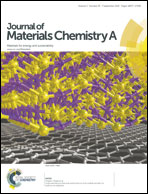Ultrathin Au nanowires supported on rGO/TiO2 as an efficient photoelectrocatalyst†
Abstract
We report the synthesis of stable rGO/TiO2/Au nanowire hybrids showing excellent electrocatalytic activity for ethanol oxidation. Phase-pure anatase TiO2 nanoparticles (∼3 nm) were grown on GO sheets followed by the growth of ultrathin Au nanowires leading to the formation of a multidimensional ternary structure (0-D TiO2 and 1-D Au on 2-D graphene oxide). The oleylamine used for the synthesis of the Au nanowires not only leads to stable Au nanowires anchored on the GO sheets but also leads to the functionalization and room temperature reduction of GO. Using control experiments, we delineate the role of the three components in the hybrid and show that there is a significant synergy. We show that the catalytic activity for ethanol oxidation primarily stems from the Au nanowires. While TiO2 triggers the formation of oxygenated species on the Au nanowire surface at a lower potential and also imparts photoactivity, rGO provides a conducting support to minimize the charge transfer resistance in addition to stabilizing the Au nanowires. Compared with nanoparticle hybrids, the nanowire hybrids display a much better electrocatalytic performance. In addition to high efficiency, the nanowire hybrids also show a remarkable tolerance towards H2O2. While our study has a direct bearing on fuel cell technology, the insights gained are sufficiently general such that they provide guiding principles for the development of multifunctional ternary hybrids.



 Please wait while we load your content...
Please wait while we load your content...